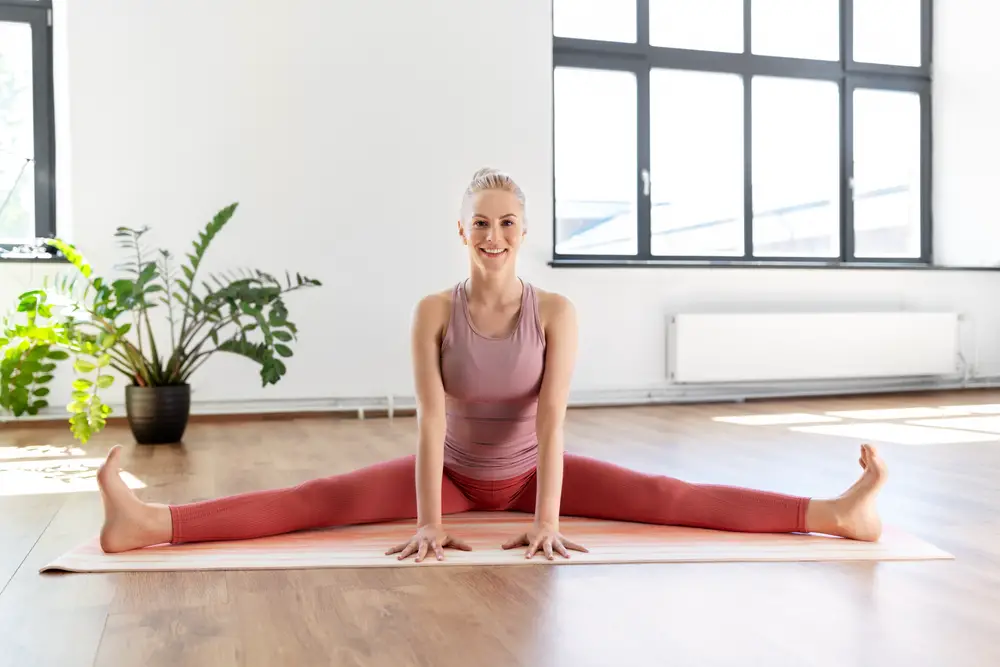Hyperbolic stretching is an advanced form of static or ballistic-type exercise that aims to increase flexibility and support muscle growth.
Developed by personal coach Alex Larsson, this technique leverages ancient stretching practices to guarantee significant improvement in flexibility and muscle training within four weeks of a standard course.
This online, self-paced workout programme is designed to help individuals strengthen their muscles, enhance their range of motion, and enable them to achieve better splits and kicks.
As a budget-friendly option, hyperbolic stretching has garnered the attention of many seeking to boost their fitness and flexibility in a short span of time.
What is Hyperbolic Stretching
Hyperbolic stretching is an advanced form of static or ballistic-type exercises that primarily focus on enhancing the range of motion in specific joints with minimal resistance (i.e., movement). This technique requires holding a stretch for an extended period to improve flexibility and, ultimately, performance.
Developed by personal coach Alex Larsson, hyperbolic stretching combines ancient stretching methods with modern understanding and guarantees significant improvements in flexibility and muscle training within a standard four-week course.
The Hyperbolic Stretching Program offers a results-oriented training approach designed to help individuals reach their full potential in just four weeks. It utilises PNF stretching techniques in an easy-to-follow format and combines dynamic and static stretches, enhancing lower body flexibility.
The program is available online and self-paced, making it easier for individuals to incorporate it into their fitness routines.
One of the main benefits of hyperbolic stretching is that it helps in improving muscle strength and flexibility, which enhances overall athletic performance. By targeting specific muscle groups, this method helps to prevent injuries due to muscle imbalances and promotes a more balanced training approach.
Additionally, the program claims to provide a significant increase in flexibility over a relatively short period of time.
In conclusion, hyperbolic stretching is an innovative and effective technique for increasing flexibility and enhancing muscle growth.
By combining ancient principles with modern techniques and understanding, Alex Larsson’s Hyperbolic Stretching Program provides a comprehensive training approach for individuals looking to achieve their full potential in flexibility and performance.
Principles of Hyperbolic Stretching
Hyperbolic stretching is a technique developed by personal coach Alex Larsson, using ancient stretching methods to increase flexibility and aid muscle growth.
The method guarantees a drastic increase in flexibility and improvement of muscle training within the four weeks of a standard course. This technique utilises two main principles: dynamic stretching and static stretching.
Dynamic Stretching
Dynamic stretching involves performing active movements that gradually increase the range of motion and flexibility of the targeted muscle group.
This type of stretching is done before a workout or physical activity to prepare the muscles and increase blood flow. Some examples of dynamic stretches include leg swings, arm circles, and high knees.
Dynamic stretching is an important component of hyperbolic stretching because it helps to activate and stimulate the muscles, warming them up for the upcoming workout.
Additionally, it can improve overall athletic performance and reduce the risk of injuries, making it an essential part of the hyperbolic stretching program.
Static Stretching
Static stretching is the process of holding a stretch for a certain period to lengthen and relax the muscles and connective tissues. It is often done after a workout or physical activity to aid in muscle recovery and flexibility improvement.
Some examples of static stretches include the seated forward bend, standing hamstring stretch, and the butterfly stretch.
In the hyperbolic stretching program, static stretching is used to increase the range of motion and flexibility of targeted muscle groups.
This type of stretching helps to break down muscle tightness and stiffness, allowing the body to move more freely and efficiently during workouts and everyday activities.
By combining dynamic and static stretching, the hyperbolic stretching technique effectively improves flexibility, muscle growth, and overall athletic performance.
Participants of this program can expect noticeable results within a four-week period by diligently following the prescribed exercises and stretches.
Benefits of Hyperbolic Stretching
Hyperbolic stretching is a technique designed to increase flexibility and aid muscle growth. Developed by personal coach Alex Larsson, it utilises ancient stretching techniques and promises significant improvements to flexibility and muscle training within a standard four-week course.
Flexibility and Range of Motion: One of the primary benefits of hyperbolic stretching is the enhancement of flexibility and range of motion (ROM) in the body.
By employing this technique, individuals are able to improve their mobility, allowing them to execute daily tasks and athletic performances with ease.
Strength and Core Stability: In addition to improving flexibility, hyperbolic stretching has been linked to increased muscle strength and core stability.
This technique focuses on activating and engaging the core muscles, resulting in better overall balance and posture.
Performance Enhancement: As the technique is designed to help muscles stretch and contract more efficiently, it can lead to improvements in athletic performance.
With greater flexibility and muscle strength, athletes can push their bodies further during training and competitions, potentially resulting in better performance outcomes.
Vitality and Relaxation: Lastly, practising hyperbolic stretching can contribute to an individual’s overall sense of vitality and relaxation. By stretching the muscles regularly, tension is released, and a state of relaxation can be achieved.
Additionally, enhancing physical abilities can lead to a sense of improved well-being and increased energy.
The Hyperbolic Stretching Program
The Hyperbolic Stretching Program is a self-paced, digital, and comprehensive training system designed to help individuals improve their flexibility, muscle strength, and overall well-being.
Created by Alex Larsson, this 4-week online program utilises a series of unique workouts and flexibility techniques suitable for both men and women.
Men’s Routine
The Men’s Routine in the Hyperbolic Stretching Program focuses on muscle growth, flexibility, and strength. The workouts are specifically designed to target common problem areas for men, such as the hamstrings, lower back, and hips, by using ancient stretching techniques.
As a result, participants can expect a significant increase in flexibility and muscle development within four weeks of diligent practice.
Women’s Routine
Similar to the Men’s Routine, the Women’s Routine in the Hyperbolic Stretching Program aims to enhance muscle strength, flexibility, and overall physique
Catering specifically to women, these workouts focus on strengthening the pelvic floor muscles, increasing overall flexibility, and promoting a general sense of well-being.
When consistently practiced throughout the four-week program, participants can expect noticeable improvements in their range of motion, balance, and muscle tone.
Achieving Splits and Kicks
Hyperbolic stretching is a powerful technique designed to improve flexibility and muscle strength, making it particularly beneficial for those aiming to achieve impressive splits and high kicks.
In this section, we will explore the importance of the side split, front split, and high kicks, along with essential tips on how to enhance these movements using hyperbolic stretching.
Side Split
The side split, also known as the straddle split, is a challenging feat that requires considerable flexibility in the hamstrings, hip flexors, and pelvic floor muscles. It involves spreading the legs wide, extending them out to the side while the torso remains upright.
Achieving a full side split demands consistent practice and patience. Hyperbolic stretching can be a game-changer in this process, as it helps loosen the muscles and progressively builds strength and flexibility in the targeted areas.
Front Split
The front split is another vital component in enhancing flexibility and overall performance in various physical activities, including gymnastics, martial arts, and dance. In a front split, one leg is extended forward, and the other is stretched backward, with both legs in a straight line.
Like the side split, executing a flawless front split requires significant flexibility in the hamstrings and hip flexors and can be attained by employing hyperbolic stretching.
This method assists in reducing tension in these muscles, enabling a smoother and quicker progression towards a full front split.
High Kicks
High kicks are a fundamental yet demanding element in many athletic disciplines, such as martial arts, cheerleading, and dance. The ability to perform high kicks with ease and precision necessitates exceptional muscle strength and flexibility in the hamstrings, hip flexors, and pelvic floor muscles.
Incorporating hyperbolic stretching in your training routine can improve kicking height and fluidity while reducing the risk of injury. By developing muscle strength and flexibility, practitioners of high kicks can achieve better control, power, and stability in their movements.
In conclusion, the integration of hyperbolic stretching into one’s training regimen can significantly facilitate the attainment of side splits, front splits, and high kicks.
This technique effectively targets key muscle groups and eliminates tension, allowing individuals to swiftly reach their flexibility and strength goals.
Incorporating Hyperbolic Stretching into Fitness
Hyperbolic stretching is a technique designed to increase flexibility and aid muscle growth. Developed by personal coach Alex Larsson, this method utilises ancient stretching practices and promises significant improvements in flexibility and muscle training within a four-week standard course.
In the fitness world, athletes, gym-goers, and anyone seeking enhanced physical performance can benefit from incorporating hyperbolic stretching into their routines.
This advanced form of static or ballistic-type exercise targets specific joints in the body, increasing their range of motion with minimal resistance.
Weightlifters often integrate hyperbolic stretching into their regime to improve flexibility, which can lead to better performance and reduced risk of injury.
Flexible muscles can execute a wider range of movements, including compound exercises that engage multiple muscle groups at once.
Similarly, runners and dancers can employ hyperbolic stretching to increase joint mobility and reduce muscle tightness, resulting in smoother and more efficient movements.
Enhanced flexibility in these activities may aid in injury prevention and lead to improved performance overall.
Yogis can also find value in utilising hyperbolic stretching techniques. Many yoga practices emphasise the importance of flexibility and strength, which can be optimised through proper stretching methods.
Hyperbolic stretching can contribute to a deeper and more balanced yoga practice by providing increased joint mobility and support for challenging poses.
Incorporating hyperbolic stretching into fitness routines allows athletes and exercise enthusiasts to unlock their full physical potential.
The technique is particularly beneficial for individuals seeking improvements in flexibility, muscle strength, and joint mobility, with a focus on injury prevention and overall physical fitness.
Safety and Injury Prevention
Hyperbolic stretching is a method designed to improve flexibility and mobility through a series of targeted exercises. It aims to enhance athletic performance while ensuring the safety of its practitioners.
This stretching technique aims to prevent injuries by focusing on specific muscle groups and areas of the body that are prone to strain, such as the hips, upper body, lower body and lower back.
One of the key elements of hyperbolic stretching is warming up the body before commencing the stretching exercises. A proper warm-up increases blood flow, delivers oxygen and nutrients to the muscles and prepares them for the upcoming activity.
Hence, incorporating light exercises such as walking, running in place or doing jumping jacks can help warm up muscles effectively.
When addressing injury prevention, it is important to consider different stretching techniques. Proprioceptive neuromuscular facilitation (PNF) and ballistic stretching are also known for enhancing the flexibility and elasticity of muscles.
However, hyperbolic stretching differs from these methods by providing a more gradual and controlled approach to stretching. This minimises the risk of overstretching or placing excessive strain on the muscles, making it a safer option for many athletes.
Another advantage of hyperbolic stretching is its focus on specific areas of the body, like hips, lower back and upper body. By targeting these regions, the technique can alleviate discomfort and help prevent back pain, a common issue among athletes and sedentary individuals alike.
Moreover, concentrating on muscle groups connected to core movement patterns increases overall mobility and functional movement, thus reducing the risk of injuries.
In addition to keeping athletes safe, hyperbolic stretching can be applied to a variety of training programmes. Whether your goal is to enhance mobility, build strength or improve athletic performance, this stretching technique is versatile enough to cater to different objectives. However, as with any exercise programme, it is crucial to listen to your body and adjust accordingly to reap the maximum benefits while avoiding potential injuries.
Notable Aspects of the Program
Hyperbolic Stretching is a method developed by personal coach Alex Larsson, which aims to increase flexibility and improve muscle training by using ancient stretching techniques.
The program, being accessible online, is suitable for both beginners and experts, as it is designed to be easy to follow and requires no specific equipment.
One important aspect of the Hyperbolic Stretching program is its beginner-friendly nature. The course adapts well to different skill levels, making it an excellent choice for those who are new to stretching exercises.
With a clear instructional format and Asian techniques, the program provides a comprehensive, yet simple approach to improving flexibility and muscle training.
Frequently Asked Questions
What are the benefits of hyperbolic stretching?
Hyperbolic stretching is said to provide many benefits, including increased flexibility, muscle growth, and improved athletic performance.
In this stretching technique, specific joints are targeted, helping to increase their range of motion with little to no resistance. Additional benefits may include improved posture, reduced risk of injury, and enhanced overall physical fitness.
How does hyperbolic stretching differ from traditional stretching?
Traditional stretching typically includes static and dynamic exercises. Hyperbolic stretching, on the other hand, is considered an advanced form of static or ballistic-type exercises.
While traditional stretching focuses on gradually lengthening muscles, hyperbolic stretching involves holding a stretch for an extended period of time, aiming to provide more significant flexibility gains in a shorter period.
How often should one do hyperbolic stretching?
Consistency is key when it comes to hyperbolic stretching, as the technique guarantees noticeable results within four weeks of a standard course.
While individual needs may vary, incorporating hyperbolic stretching into one’s routine several times a week is generally recommended for optimal results.
Can hyperbolic stretching help with athletic performance?
Yes, hyperbolic stretching has been reported to enhance athletic performance. Increased range of motion, flexibility, and muscle growth can contribute to better overall performance in various physical activities and sports.
Additionally, improved posture and reduced risk of injury may lead to a more efficient and effective movement.
Is hyperbolic stretching suitable for everyone?
Hyperbolic stretching is designed to be beginner-friendly and can be helpful to individuals of different fitness levels. However, as with any exercise program, it is essential to consult with a healthcare professional or qualified trainer before starting, especially if you are dealing with existing injuries or health issues.
Are there any potential drawbacks or risks of hyperbolic stretching?
As with any exercise technique, there might be some risks associated with hyperbolic stretching. Overstretching or performing stretches improperly may lead to muscle strains or injuries.
It’s crucial to follow the program guidelines carefully and progress at a safe pace that is appropriate for your current fitness level. Listening to your body and seeking guidance from a qualified professional can help reduce any potential risks.

I’m Jennifer a beauty and wellness expert. I believe in promoting a sustainable and healthy lifestyle from within. Helping people feel good is my passion; whether it’s teaching yoga or offering skincare advice.







